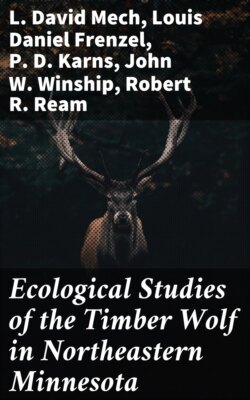Читать книгу Ecological Studies of the Timber Wolf in Northeastern Minnesota - Robert R. Ream - Страница 6
THE STUDY AREA
ОглавлениеThis study was conducted in the Superior National Forest (fig. 1) in northern St. Louis, Lake, and Cook Counties of northeastern Minnesota (92° west longitude, 48° north latitude), an area well described by Stenlund (1955). Most of the data were collected from within and immediately south of the Boundary Waters Canoe Area, a special wilderness region in which travel by motorized vehicles is restricted. The total study area encompasses approximately 1.5 million acres, and numerous lakes and rivers comprise about 15 percent of this area (fig. 2). The topography varies from large stretches of swamps to rocky ridges, with altitudes ranging from 1,000 to 2,300 feet above sea level (fig. 3). Winter temperatures lower than −30° F. are not unusual, and snow depths generally range from 20 to 30 inches on the level. However, an important exception occurred in early 1969 when depths of 45 inches and more accumulated in much of the area. Further details on snow conditions in the study area during the period of this investigation are given by Mech et al. (see page 51). Conifers predominate in the forest overstory, with the following species present: jack pine (Pinus banksiana Lamb.), white pine (P. strobus L.), red pine (P. resinosa Ait.), black spruce (Picea mariana (Mill.) B.S.P.), white spruce (P. glauca (Moench) Voss), balsam fir (Abies balsamea (L.) Mill.), white cedar (Thuja occidentalis L.), and tamarack (Larix laricina (DuRoi) K. Koch). However, as a result of extensive cutting and fires much of the conifer cover is interspersed with large stands of white birch (Betula papyrifera Marsh.) and aspen (Populus tremuloides Michx.). Detailed descriptions of the forest vegetation were presented by Ohmann and Ream (1969).
Figure 1 (left half)—Map of the study area. (Click for larger image.)
Figure 1 (right half)—Map of the study area. BOUNDARY WATERS CANOE AREA SUPERIOR NATIONAL FOREST (Click for larger image.)
Figure 2.—Lakes are common throughout most of the study area. (Photo courtesy of L. D. Mech.)
Figure 3.—Ridges, islands, swamps, and bays are part of the variable topography in the Superior National Forest. (Photo courtesy of L. D. Mech.)
